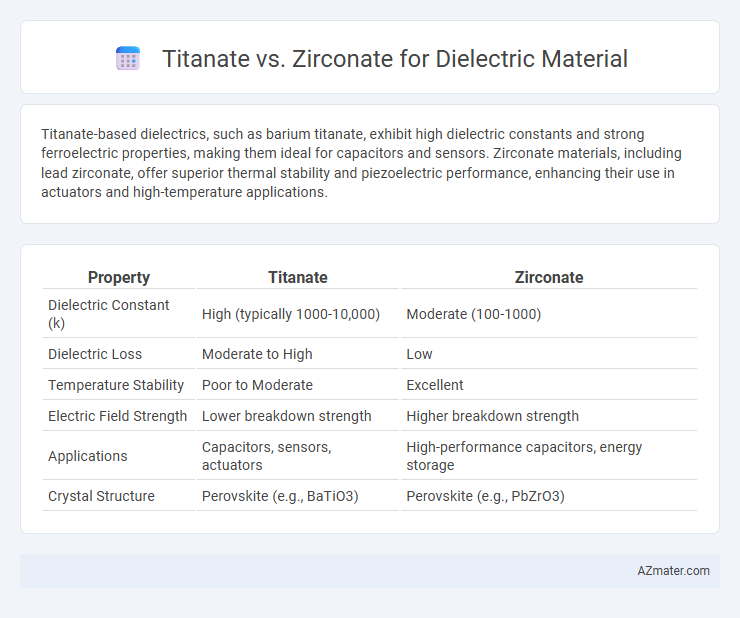Titanate-based dielectrics, such as barium titanate, exhibit high dielectric constants and strong ferroelectric properties, making them ideal for capacitors and sensors. Zirconate materials, including lead zirconate, offer superior thermal stability and piezoelectric performance, enhancing their use in actuators and high-temperature applications.
Table of Comparison
| Property | Titanate | Zirconate |
|---|---|---|
| Dielectric Constant (k) | High (typically 1000-10,000) | Moderate (100-1000) |
| Dielectric Loss | Moderate to High | Low |
| Temperature Stability | Poor to Moderate | Excellent |
| Electric Field Strength | Lower breakdown strength | Higher breakdown strength |
| Applications | Capacitors, sensors, actuators | High-performance capacitors, energy storage |
| Crystal Structure | Perovskite (e.g., BaTiO3) | Perovskite (e.g., PbZrO3) |
Introduction to Dielectric Materials
Dielectric materials such as titanates and zirconates are crucial in capacitors and electronic components for their ability to store and release electrical energy efficiently. Titanates, including barium titanate (BaTiO3), exhibit high dielectric constants and strong ferroelectric properties, making them ideal for high-performance capacitors and piezoelectric devices. Zirconates, like lead zirconate (PbZrO3), offer superior thermal stability and moderate dielectric constants, often utilized in applications requiring robust dielectric response under varied temperature conditions.
Overview of Titanate-Based Dielectrics
Titanate-based dielectrics, prominently featuring barium titanate (BaTiO3), exhibit high dielectric constants and strong ferroelectric properties, making them essential for capacitors and memory devices. These materials offer temperature stability and tunable dielectric response, crucial for applications requiring miniaturization and performance consistency. Compared to zirconate-based dielectrics, titanates typically provide higher permittivity but may require careful control of grain size and doping to optimize dielectric loss and breakdown strength.
Overview of Zirconate-Based Dielectrics
Zirconate-based dielectrics, particularly lead zirconate titanate (PZT), exhibit exceptional ferroelectric and piezoelectric properties, making them integral in capacitors, sensors, and actuators. Their high dielectric constant, thermal stability, and tunable electric polarization outperform many titanate-only materials, enabling superior energy storage and electromechanical coupling. Optimization of zirconate compositions enhances dielectric performance, balancing permittivity and dielectric loss for advanced electronic applications.
Chemical Structure Comparison: Titanate vs Zirconate
Titanate dielectrics, such as barium titanate (BaTiO3), feature a perovskite crystal structure characterized by Ti4+ ions centrally coordinated by oxygen octahedra, enabling high dielectric constants through ferroelectric polarization. Zirconates like barium zirconate (BaZrO3) share a similar perovskite framework but contain Zr4+ ions, which exhibit more symmetric and less polarizable octahedral coordination, resulting in lower dielectric constants and higher thermal stability. The difference in cation size and electronic configuration between Ti4+ and Zr4+ directly influences lattice distortions, polarization behavior, and ultimately the dielectric performance of these materials.
Dielectric Properties and Performance Metrics
Titanate-based dielectrics, such as barium titanate, offer high dielectric constants typically ranging from 1000 to 5000, making them ideal for capacitor applications requiring large energy storage. Zirconate materials, including lead zirconate, exhibit moderate dielectric constants around 200 to 1000 but provide superior temperature stability and lower dielectric loss, enhancing performance in high-frequency environments. Key performance metrics like dielectric breakdown strength, loss tangent, and temperature coefficient demonstrate that titanates excel in capacitance density, while zirconates ensure consistent operation under thermal stress.
Temperature Stability and Reliability
Titanate-based dielectric materials exhibit high dielectric constants but often suffer from significant temperature-dependent variations, reducing their stability in fluctuating thermal environments. Zirconate dielectrics demonstrate superior temperature stability with minimal dielectric constant change over a wide temperature range, enhancing reliability in electronic applications. The robust crystalline structure of zirconates contributes to their consistent performance and prolonged operational lifespan under thermal stress.
Applications in Capacitors and Electronics
Titanate materials, such as barium titanate, exhibit high dielectric constants and excellent temperature stability, making them ideal for multilayer ceramic capacitors (MLCCs) used in mobile devices and automotive electronics. Zirconate compounds, including lead zirconate, provide robust ferroelectric properties and superior piezoelectric responses, which are critical in sensors, actuators, and non-volatile memory applications. The choice between titanate and zirconate dielectrics depends on the required capacitance density, voltage tolerance, and operational stability in electronic circuits.
Processing Techniques and Fabrication Differences
Titanate-based dielectrics typically require high-temperature sintering processes around 1200degC to achieve dense microstructures, whereas zirconate-based materials often allow for lower temperature processing, improving energy efficiency during fabrication. Titanates are commonly fabricated using solid-state reaction methods that involve prolonged milling and calcination, while zirconates frequently utilize sol-gel or chemical solution deposition techniques for better compositional control and film uniformity. The processing differences result in varied grain sizes and dielectric properties, with zirconates often exhibiting enhanced tunability and lower dielectric loss in capacitor applications.
Cost and Availability Considerations
Titanate-based dielectric materials generally offer a lower cost and wider availability due to abundant raw materials and established manufacturing processes, making them suitable for large-scale electronic applications. Zirconate dielectrics tend to be more expensive and less readily available, often limited by the scarcity of zirconium and complex synthesis methods. Cost-efficiency and material accessibility favor titanates for commercial production, while zirconates may be reserved for specialized high-performance dielectric components.
Future Trends and Research Directions
Titanate-based dielectrics exhibit high permittivity and tunable properties, making them promising for next-generation capacitors, while zirconate materials offer superior thermal stability and resistance to aging, critical for high-frequency applications. Research is increasingly directed toward hybrid titanate-zirconate composites to optimize dielectric constant and loss tangent simultaneously, with efforts in nanoscale engineering and doping strategies enhancing performance under extreme conditions. Future trends emphasize flexible and miniaturized electronic devices, driving the development of environmentally friendly, lead-free titanate and zirconate ceramics with improved energy storage density and long-term reliability.

Infographic: Titanate vs Zirconate for Dielectric material
 azmater.com
azmater.com